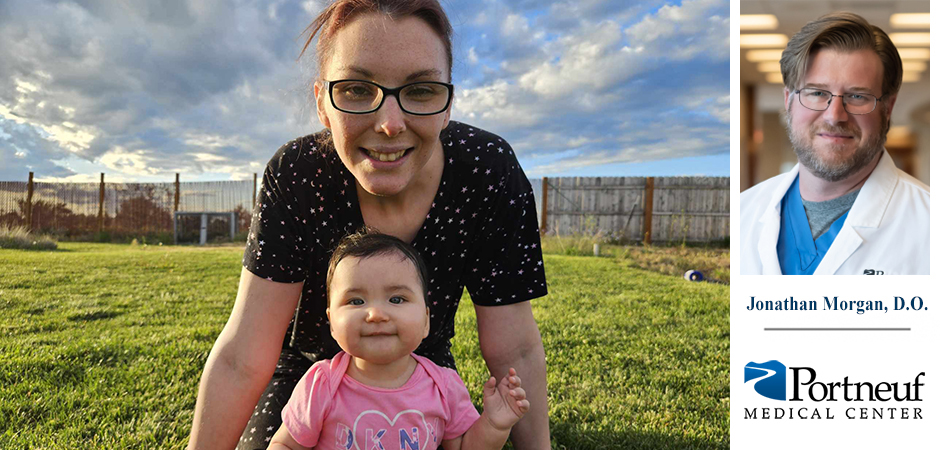
In her job as a dispatcher – answering the emergency number for the Fort Hall, Idaho Police Department – Jammie Waterhouse knew that any call could be an emergency. She never imagined that one day the emergency would involve her.
Waterhouse had been on the job for nine years, starting when she was 25 years old, a year before she married her husband Aaron. Now 35, she and Aaron are still looking toward the future.
“Aaron and I were married in July 2015,” Waterhouse recalled. “He came from a larger family than me, but we always talked about having kids.” For the next few years, life was good for the newlyweds. Then at the end of 2018, Waterhouse started experiencing severe migraine headaches.
“It was a surprise when the headaches started,” she said. “I had no chronic illnesses or underlying conditions. I was healthy as a horse, but these migraines were intense.”
The pain was so great that Waterhouse was treated with monthly injections of Toradol, a nonsteroidal anti-inflammatory drug that helps decrease inflammation. She continued working 12-hour night shifts at the 911 dispatch center, waiting a few days after each injection before returning to work.
Emergency trip
One day she was working the day shift and the headache pain would not subside. She tried to work without the bright overhead lights, but the darker room didn’t help much. That’s when she called one of her supervisors and said she had to go to the hospital.
“Something was very wrong,” she realized. “I was dizzy, I couldn’t see well and was getting very nauseous.” She called her husband at work and asked him to take her to the hospital. “All I wanted to do was sleep in a dark room because my head was pounding.”
Fortunately, they went directly to the Emergency Department at Portneuf Medical Center, where she received a CT scan.
“I only remember bits and pieces during that time,” said Waterhouse, “but Aaron was with me and said that the CT scan showed a small dark spot on the left side of my brain, near the temporal lobe which controls short-term memory.”
The doctors then performed an MRI on Waterhouse, which identified a mass on her brain about the size of a small orange. Waterhouse was immediately admitted to the hospital and surgery was scheduled for the next day.
Fearlessly facing the odds
Waterhouse was diagnosed with Stage 4 Glioblastoma – a brain tumor in its final stage – a serious diagnosis as patients with this type and severity of cancer are, on average, expected to live only 12-18 months more.
According to the National Brain Tumor Society, survival rates and mortality statistics for patients with Stage 4 Glioblastoma have been virtually unchanged for decades. The five-year survival rate for glioblastoma patients is only 6.9%.
Waterhouse’s initial diagnosis took place more than 60 months ago, so she is counted as one of those five-year survivors.
“The doctors told me that my cancer will never really be in remission,” she said. “I will need regular scans every year to confirm cancer has not reappeared.”
The surgery was successful in removing the mass, but nearby cancer cells remained. Waterhouse was then scheduled for radiation and chemotherapy to eliminate the remaining cancer cells.
Before she started those treatments, Waterhouse went to Boise as only the second patient to participate in a new clinical trial.
As part of the trial, Waterhouse ingested a pink-colored drink that would highlight the location of cancer cells in her brain. Doctors performed a second craniotomy to remove the highlighted cancerous cells.
Doctors also placed small, flat wafers in the left area of her brain. Each wafer had a small dose of chemotherapy, which provided consistent medication to fight any cancer cells that may reappear.
Family time
 Through it all, Waterhouse never gave up hope of starting a family. She had asked her chemotherapy doctor in Boise if it was still possible for her to have children.
Through it all, Waterhouse never gave up hope of starting a family. She had asked her chemotherapy doctor in Boise if it was still possible for her to have children.
“He did not give me a direct yes or no answer,” recalled Jammie. “I think he didn't want to give me false hope.”
When they left the Boise hospital, Jammie and Aaron decided to research on their own whether a person who had received high doses of radiation and chemotherapy could conceive a child. They determined that they had about a 1% chance of delivering a healthy baby despite the radiation and chemotherapy that had been pumped into her body.
Yet, on August 7, 2023, she gave birth to McKenzie Loretta Waterhouse – a healthy baby girl.
“McKenzie is doing well,” said Waterhouse. “We see a little bit of Aaron and me in her, especially her spirit!”
The couple hopes to take their daughter to Disneyland when she is four or five years old, so they have started saving for their trip. In the meantime, they will make memories with McKenzie at nearby sites like the Idaho Falls Zoo at Tautphaus Park.
This past Mother’s Day was a special memory for Waterhouse, as McKenzie said “Mom” for the first time. Through it all, Waterhouse has maintained her positive attitude to greet each day and deal with everything as best she can.
“Despite everything, I am truly blessed,” she said.
For more information about the Cancer Center at Portneuf Medical Center, visit our website or call us at (208) 239-1720.